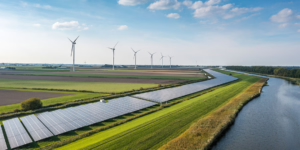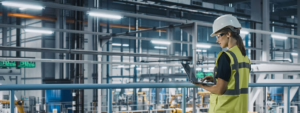
Agriculture & Food
Whether you are a farmer, food producer, or agri-tech innovator, you face constant pressure to deliver safe, high-quality, and sustainable products while keeping costs under control. Photonics — the science and technology of light — gives you powerful tools to achieve this.
Photonics offers endless possibilities
Discover how you can:
- Reduce energy costs through smart lighting systems
- Optimise harvest yields through monitoring soil and plant health
- Assure food safety through smart imaging and storage monitoring
And so much more!

How photonics can support your innovation
Photonics helps to supply safe, nutritious and affordable food for all and establish a sustainable value chain from farm to fork. By using ever more precise sensors and measuring devices, farmers, technology providers, food processors and consumers will be able to monitor and certify the safety, quality, content and even the origin of food – anytime and anywhere.
Photonics technologies can monitor soil health and hydrology, predict protein levels in grain harvests, determine when to pick fruit, map water quality to check the health of fish stocks, and more.

How photonics is applied in Agriculture & Food
Curious how photonics can support your work? These examples show how light-based technologies are already helping farmers, producers, and food innovators to grow smarter, reduce waste, and deliver safer, healthier products.
Apply for innovation support
LED & laser-based sorting systems
These systems use light to sort food products with extreme accuracy. By detecting size, shape, color, and even internal defects, they can separate high-quality produce from damaged items at high speed. This improves efficiency, reduces waste, and ensures consistent product quality for consumers.
Lighting systems for vertical farming
Tailored LED lighting enables crops to grow indoors under controlled conditions. By fine-tuning light spectrum and intensity, growers can shorten growth cycles, reduce energy use, and increase yields year-round — making vertical farming a sustainable solution for urban food supply.
Humidity sensors
Humidity directly affects freshness and shelf life. Optical humidity sensors provide real-time monitoring in storage or packaging, helping producers maintain ideal conditions, reduce spoilage, and deliver food that stays fresher for longer.
Optical systems for food condition monitoring and ripeness detection
Spectral analysis makes it possible to check ripeness, freshness, and internal quality without damaging the product. Farmers can pick crops at just the right moment, processors can cut down on waste, and consumers enjoy food at its best.
Hyperspectral camera systems for soil and plant health
Hyperspectral imaging reveals details invisible to the eye. From detecting nutrient stress in plants to monitoring soil composition, it provides farmers with actionable insights for precision agriculture — saving water, fertilizers, and resources while boosting yields.
Laser systems for weed control and environmental sensing
Lasers offer a chemical-free way to manage weeds, reducing reliance on herbicides and protecting ecosystems. Combined with optical sensors, these systems can also monitor greenhouse gases and other environmental factors, supporting sustainable farming practices.
Optical detection systems for pesticides, toxins, and contamination
Advanced sensors can rapidly identify harmful substances in food, from pesticide residues to toxins or microbial contamination. This ensures food safety, supports compliance with regulations, and builds consumer trust.
Inspection systems for food packaging
Photonics-based inspection ensures packaging is sealed correctly, labels are accurate, and contents are intact. This avoids costly recalls, guarantees food safety, and ensures products reach consumers in perfect condition.
Lab-on-chip food quality diagnostics
These miniaturized devices bring lab testing directly to the field or production line. Farmers and producers can perform instant checks for pathogens, allergens, or chemical residues — making quality control faster and more accessible.
PIC MIR gas sensors for storage monitoring
Photonic integrated circuit (PIC) sensors operating in the mid-infrared range detect trace gases such as ethylene, carbon dioxide, or ammonia in storage environments. Monitoring these gases helps prevent spoilage, extend shelf life, and optimize storage conditions.












